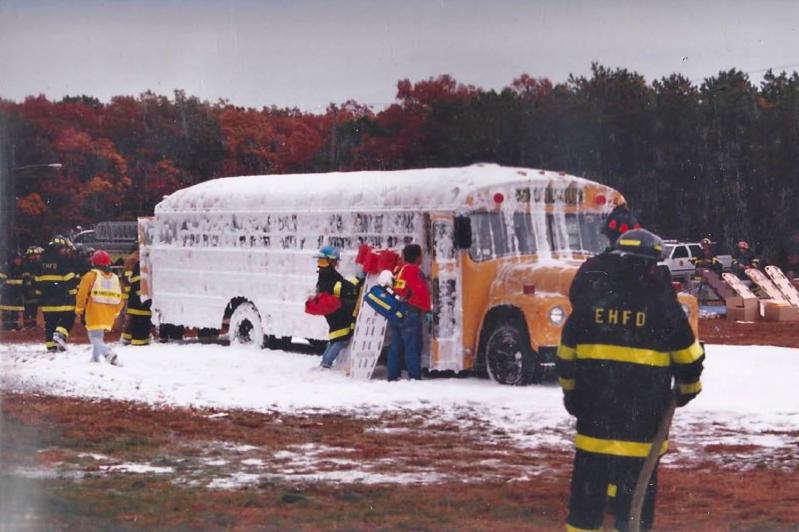Ongoing litigation in federal court between East Hampton Town and East Hampton Village over the use and storage of controversial firefighting foam at the town airport by the village’s Fire Department remains in limbo even as the State Department of Environmental Conservation “continues to oversee the town’s remedial investigation” at the site, the agency said this week.
The battle between the town and village dates back to April of 2020, when the town sued the village and its insurer, American Alternative Insurance Corporation, in the United States District Court for the Eastern District of New York, over costs it continues to incur in dealing with toxic chemicals used in firefighting foam that was reportedly stored in 55-gallon drums at the firefighting substation by the airport in Wainscott and on its special airplane-crash firefighting vehicle. (The town owns the airport; the volunteer Fire Department is overseen by the village.)
The firefighting material, aqueous film-forming foam, or A.F.F.F., contains the toxic perfluorooctane sulfonate, or PFOS, and perfluorooctanoic acid, or PFOA, which were discovered to have leached into the groundwater in 2017, contaminating hundreds of private wells in Wainscott.
At that time, the town first provided bottled water to affected residents and then paid to extend Suffolk County Water Authority mains for them to hook up to.
The discovery of A.F.F.F contamination at the airport and its reported use at the Fire Department’s nearby training facility led to a state Superfund designation at the airport and an ongoing remediation investigation led by the town and overseen by the D.E.C.
According to the most recent, amended filing in the case — from May of 2022 — the site is registered as a Class 2 site in the state’s Registry of Inactive Hazardous Waste Disposal Sites.
As such, and according to the D.E.C., it represents a significant threat to public health or the environment and requires remedial action. The remedial investigation underway by the town is to determine the nature and extent of contamination at and emanating from the site.
To address the contamination, the town entered into a consent order with the D.E.C. in August of 2020 for the remedial-investigation work, and as part of the agreement, paid $327,186 to the D.E.C. for reimbursement of the agency’s costs associated with making the Superfund declaration. The D.E.C. also sent the town another invoice for $49,070 for costs incurred by the agency and the New York State Department of Health related to A.F.F.F. contamination, which dated back to 2016.
In anticipation of its compliance with the D.E.C.’s requirement that the town submit a remedial investigation work plan, attorneys for the town sent a letter in March of 2020 to the village’s counsel, asking for information and documentation of where the Fire Department had used and stored A.F.F.F. in and around the Superfund site, from 1960 through the present.
According to the amended federal court filing from last May, the village responded by refusing to provide the information as it declared that the town’s “discovery demand is inappropriate.”
A July 2020 letter from the village to the town then “failed to identify a single location” where the fire department “used or may have used A.F.F.F.,” the amended court filing notes, “and stated that [the] village’s investigation was ‘ongoing’ notwithstanding the lengthy time period [the] village has had to conduct such investigation.”
A statement Friday from the D.E.C.’s press office says that the agency “remains committed to working with the town to develop a remediation plan and full cleanup of the site to ensure the protection of public health and the environment.”
But according to the amended complaint filed last May by the town’s outside counsel in this matter, Nicholas Rigano, more than two years after the suit was initiated, the village still had not provided the town with a comprehensive list of places where the A.F.F.F. was used or stored.
Mr. Rigano could not comment for this story, he said, given the pending litigation, nor could East Hampton Town Supervisor Peter Van Scoyoc.
According to the amended suit, the foam was reportedly used to extinguish flames from at least one plane crash at the airport, and was also utilized during training exercises at the fire department’s Lawrence Franzone Fire Training facility on Industrial Road.
Marcos Baladron, the East Hampton Village administrator, told The Star via email that neither he nor lawyers for the village could comment on the pending litigation but did say that to the best of his knowledge, attorneys for the village had not filed a response to the May 2022 amended complaint as of late December.
The amended complaint from Mr. Rigano charges that from the time the town sent a letter to the village in November 2019 asking for further information on the extent and locations at which the Fire Department deployed the foam that the village “has failed to commence any action to redress the endangerment referenced in the letter and continues to withhold material information from the town regarding locations where E.H.F.D. used and stored” the material.
The filing identifies numerous times that the foam was used at the airport between 2007 and 2017, and in a footnote says that the “A.F.F.F. events listed in this section are examples of” the Fire Department’s use and storage of the aqueous film-forming foam, and “should not be deemed an exhaustive list. [The] town expects discovery to reveal additional uses/locations” within the airport boundaries “and/or the Superfund site” where the department used or stored the foam and washed equipment “as well as PFOA/PFOS contamination in those areas.”
Mr. Rigano’s amended complaint states that “the town’s cost to investigate and remediate the contamination at and emanating from the Superfund site will cost tens of millions of dollars,” and that to “address the contamination caused by E.H.F.D., the town has paid millions of dollars and will pay millions more” at the direction and oversight of the D.E.C. and State Department of Health, “to protect the health and safety of its residents.”
“Instead of assisting the town,” the complaint reads, the “village has stonewalled the town from obtaining pertinent information, has not cooperated with the town’s efforts, and has refused to contribute any funds to address the contamination.”
The D.E.C. could not say when it expected the remedial investigation to be completed, but when it is, the agency will then move to evaluate cleanup alternatives and propose a remedy in a document called a Proposed Remedial Action Plan.
That plan will be open to public comment for 30 days and the D.E.C. will then hold a public meeting to discuss the findings and the proposed remedy. It will then formalize the final remedy in a document called a Record of Decision.




